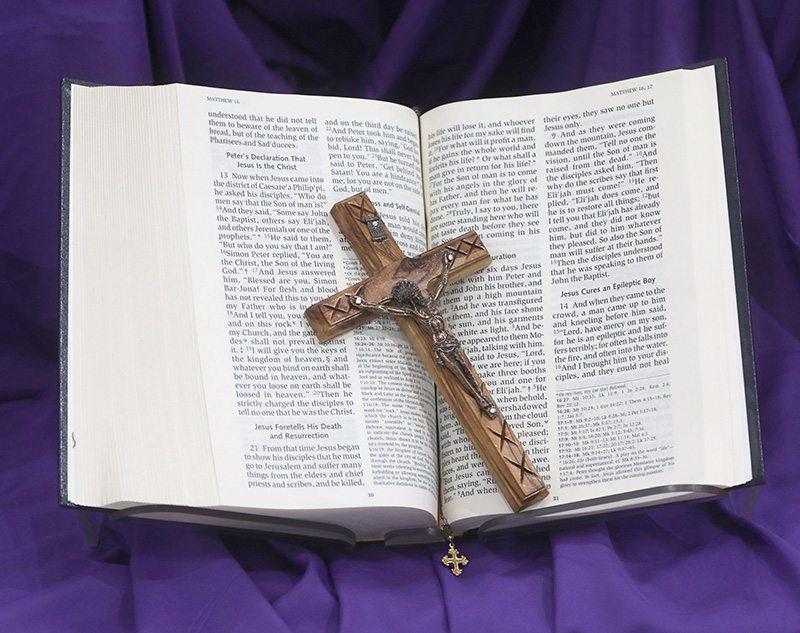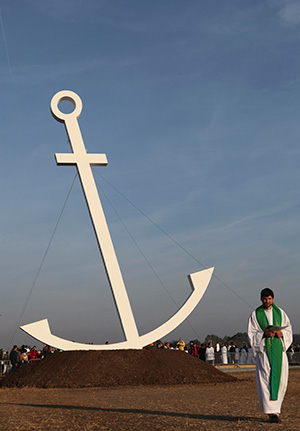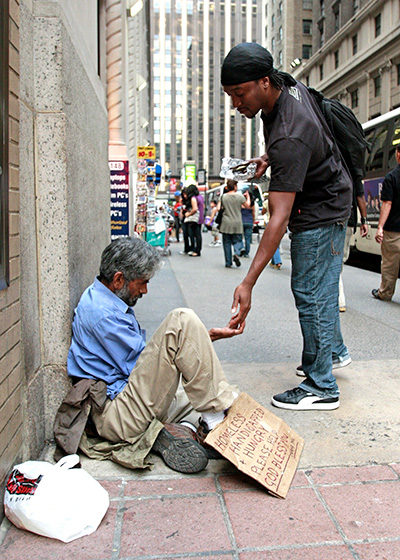 CHARLOTTE — Lent gets its name from a word meaning “springtime,” the time of year when the hours of daylight are lengthening and the sun is bringing back its warmth and light.
CHARLOTTE — Lent gets its name from a word meaning “springtime,” the time of year when the hours of daylight are lengthening and the sun is bringing back its warmth and light.
The Lenten season is a time of hope: We deepen our relationship with Christ through our Lenten disciplines and look to His crucifixion, death and resurrection to overcome the darkness that can cause us to struggle and despair.
Some days we may not feel the love of God that is always present, but we can rely on hope to move us forward in faith, especially during this Jubilee Year, which Pope Francis has given the theme “Pilgrims of Hope.” Exercise hope this Lent and find renewal for the coming Easter season.
Hope is a theological virtue, a gift from God that helps us act as His children. Received at baptism, hope gives us confidence and inspiration as we look forward to salvation. Hope allows us to move forward in faith even in the most difficult times. Hope can help us feel secure in the midst of our own failings or the injustices we see in the world around us.
St. Thomas Aquinas said, “Hope denotes a movement or a stretching forth of the appetite toward an arduous good.” In other words, we are reaching for the goodness of God when we exercise hope – even when it isn’t easy.
Hope is also a form of trust in, and surrendering to our loving God. We have faith in His goodness, and we trust His guidance for our lives. And, while hope is a gift, it is also an active choice we make to stretch toward God’s goodness.
This stretching exercise can take many forms as we live the days of Lent.
 A pedestrian gives money to a homeless man sitting outside St. Francis of Assisi Church in New York City. Almsgiving, donating money or goods to the poor and performing other acts of charity, is one of the three pillars of Lent, along with prayer and fasting. (OSV News)Pray with hope
A pedestrian gives money to a homeless man sitting outside St. Francis of Assisi Church in New York City. Almsgiving, donating money or goods to the poor and performing other acts of charity, is one of the three pillars of Lent, along with prayer and fasting. (OSV News)Pray with hope
The season of Lent calls us to deepen our prayer lives. St. Padre Pio’s famous phrase, “Pray, hope and don’t worry,” is a reminder that prayer can give us comfort when we place our hope in God. Prayer shows our reliance on and confidence in God. Along with traditional Catholic prayers, it is helpful to pray with God’s Word. This Lent, renew your prayer life by reflecting on these hope-filled Scripture passages:
“We who have taken refuge might be strongly encouraged to hold fast to the hope that lies before us. This we have as an anchor of the soul, sure and firm” (Heb 6:18-19).
“Rejoice in hope, endure in affliction, persevere in prayer” (Rom 12:12).
“May the God of hope fill you with all joy and peace in believing, so that you may abound in hope by the power of the Holy Spirit” (Rom 15:13).
“Let us hold unwaveringly to our confession that gives us hope, for He who made the promise is trustworthy” (Heb 10:23).
Another way to deepen our faith this Lent is to learn and recite the Act of Hope. Consider God’s mercy as you reflect on Christ’s death and resurrection and find hope in the promise of salvation: “O my God, relying on Your infinite mercy and promises, I hope to obtain pardon of my sins, the help of Your grace, and life everlasting, through the merits of Jesus Christ, my Lord and Redeemer. Amen.”
Fast with hope
During Lent, Catholics are called to days of fasting from food and abstinence from meat. The goal is to deepen our relationship with Christ as we experience sacrifice in honor of his sacrifice for us. Fasting can help us feel solidarity with the poor. Many Catholics traditionally “give up” something for Lent. Here are some ideas to make your Lenten sacrifice a hope-building exercise.
Refrain from negative or comments; try saying things only in positive ways. Avoid watching television or movies with negative messages. Give away items that are burdening you with clutter; find new homes for them with a charity. Trade the time you usually spend on screens to take walks with family or friends. Skip buying desserts or treats and use the money you save to purchase flowers for someone who needs a day-brightener.
As you fast, consider Pope Francis’ April 2017 TED Talk in which he addressed misconceptions around hope: “Feeling hopeful does not mean to be optimistically naive and ignore the tragedy humanity is facing. Hope is the virtue of a heart that doesn’t lock itself into darkness, that doesn’t dwell on the past, (that) does not simply get by in the present, but is able to see a tomorrow. … And it can do so much, because a tiny flicker of light that feeds on hope is enough to shatter the shield of darkness.”
Give alms with hope
“It is in giving that we receive,” according to the Prayer of St. Francis. Almsgiving can seem the easiest of Lenten disciplines. Most of our parishes have opportunities to donate funds to missions or the poor, and these are important works of charity.
 A priest walks past a large anchor before a Mass celebrated by Pope Benedict XVI in Brno, Czech Republic, Sept. 27, 2009. (Catholic News Service)Giving funds to help support others has been a part of Lent since the earliest days of Christianity and brings hope to others. However, as St. Teresa of Kolkata said, “It’s not how much we give but how much love we put into the giving” that’s important.
A priest walks past a large anchor before a Mass celebrated by Pope Benedict XVI in Brno, Czech Republic, Sept. 27, 2009. (Catholic News Service)Giving funds to help support others has been a part of Lent since the earliest days of Christianity and brings hope to others. However, as St. Teresa of Kolkata said, “It’s not how much we give but how much love we put into the giving” that’s important.
This Lent, consider volunteering at your parish during one of its Lenten activities, or help clean or decorate the church in preparation for Holy Week. Write cards to family and friends expressing ways they help you feel more hopeful. At Mass, introduce yourself to one new person each week of Lent and show them God’s love by sitting with them during the liturgy. Actively watch for someone each day who needs an extra helping hand.
You could also keep a Lenten Hope List. Write down names of those you encounter who need an extra dose of love and support. Pray for them and check in with them during Lent to show your care.
St. Bonaventure summed things up nicely: “Three things are necessary to everyone: truth that brings understanding, love of Christ which brings compassion, and endurance of hope which brings perseverance.” While Lent is traditionally the season to renew and refocus our discipleship through deeper experiences of prayer, fasting and almsgiving, it is important to remember that Christians are also called to live in hope.
— OSV News
The anchor, a symbol of hope amid storms
Did you know that the anchor represents hope? During the time of Roman persecution of Christians, it was adopted as a Christian symbol because it forms a cross. It was found in the catacombs and in homes, serving as an encouragement to Christians without drawing the attention of authorities. Since that time, the anchor cross is found in many churches and reminds us of hope and stability in Christ. As you meditate on the cross this Lent, consider the anchor cross and use it as an inspiration for hope in stormy times.
 BALTIMORE — The ancient Christian tradition of marking doorways with blessed chalk on the feast of the Epiphany will carry new meaning for many Catholics in 2021.
BALTIMORE — The ancient Christian tradition of marking doorways with blessed chalk on the feast of the Epiphany will carry new meaning for many Catholics in 2021.
Following a year that saw families shaken by the coronavirus pandemic, the traditional home blessing will serve as a special symbol of hope and a visible reminder of faith.
"Many have fought COVID-19 and lived to tell about it," said Michael Carnahan, a parishioner of Sacred Heart of Mary Church in Baltimore, who has practiced the chalk blessing since he was a child.
"However, many people have suffered the loss of a loved one to this virus. The chalk, along with other symbols, will be an even stronger reminder of how important God is to us and of what an important factor Jesus is in our daily lives," he said.
The blessing, popular in Poland and other Slavic countries, has spread to many parts of the world. It takes place on the liturgical feast marking the visitation of the Magi to the Christ Child and the revelation that Jesus is the son of God.
The blessing involves taking simple chalk, usually blessed by a parish priest, and scrawling doorways with symbolic numbers and letters -- this year: "20+C M B 21."
The numbers represent the current year and the letters stand for the first letters of the traditional names of the magi: Caspar (sometimes spelled "Kaspar"), Melchior and Balthazar. The letters are also an abbreviation for "Christus Mansionem Benedicat," Latin for "May Christ bless this dwelling."
Participants typically read passages from the New Testament and may sing Epiphany hymns.
Carnahan, along with his wife, Malgorzata Bondyra, and their five children, plan to take part in the tradition this Epiphany, which is observed in the United States this year from Jan. 3-8. Of Polish background, they will say the blessing in Polish and English.
"We will use this as an opportunity to remember that living a Christ-like existence on a daily basis is important to all," Carnahan said. "Just as we took for granted our health and safety as a society, we are reminded of how we might sometimes take for granted the sacrifice Jesus made for all of us."
2021 won't be the first time the blessing has taken on extra meaning. Under Soviet-dominated Poland, for example, Catholics viewed the blessing as a means of spiritual resistance.
"During communist times, Polish people would use the chalk and other symbols as a statement of their beliefs and as an indication that communism can't take away their faith," said Carnahan, a longtime member of the Polish dance ensemble, Ojczyzna, based at Holy Rosary Church in Baltimore. "It sometimes would lead to trouble for them, but ultimately it was a way to be defiant while also being true to their faith."
Will and Amy Buttarazzi, parishioners of St. Joseph Church in Cockeysville, Maryland, have also practiced the chalk blessing at their home with their eight children. As the director of family ministry at their parish, Amy Buttarazzi encourages other families to adopt the practice. She made a video about the tradition and provided written instructions.
She remembers her elementary school, the School of the Cathedral of Mary Our Queen in Baltimore, maintaining the tradition when she was growing up.
"Our principal would bless all the doors of the school building every year after we returned from Christmas break," she said. "The blessing would be written on a sentence strip and taped to the top frame of each door in the building. Now, as a mom, I wanted to continue this tradition in my own home with my children."
The Buttarazzis write their Epiphany blessing above the door of their dining room, while Carnahan and his family write it above their front door, outside.
Carnahan noted that the magi traveled far, having faith they would find the infant Jesus. They did so knowing his mission, he said.
"The chalk is a daily visual symbol for us," Carnahan said, "just like seeing the crucifix hanging on the wall, helping us to keep within us thoughts of grace, love, peace, happiness, forgiveness and more."
— George P. Matysek Jr., Catholic News Service
More online:
A guide for doing a chalk blessing at home: bitly.com/chalkblessing
Pictured: An incensing and chalking all of the doors at St. Mark Church, St. Mark School and Christ the King High School was held Jan. 4, 2020. (Photo provided by Amy Burger)


